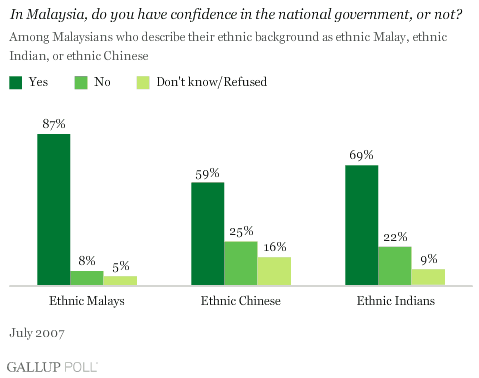WASHINGTON, D.C. -- Next week, Malaysia's ethnic Indians and ethnic Chinese populations will go to one of the few places they can legally voice their growing distaste for policies that favor the ethnic Malay majority -- the election polls. A ���۴�ýPoll conducted in Malaysia last July found that ethnic Chinese and Indian minorities were significantly less likely than ethnic Malays were to express confidence in their government.

���۴�ýobserved similar support and similar gaps by ethnicity when respondents were asked whether they approve of the country's leadership: 82% of ethnic Malays said they approved of their country's leadership, compared with 57% of ethnic Chinese and 67% of ethnic Indians who said the same.
These gaps may reflect constant frustration that ethnic Chinese and Indians feel toward affirmative action policies that grant the ethnic Malay majority privileges in business and education. Their attitudes appear to be susceptible to events that further feed this frustration: In November 2007, several months after the poll was taken, Malaysia's government used water cannons, tear gas, and police batons to silence ethnic Indians' protests against discrimination. Following the crackdown, a Merdeka Center survey of registered Malaysian voters in December showed a 41-percentage point drop in ethnic Indians' approval of Prime Minister Abdullah Ahmad Badawi's job performance.
The ���۴�ýsurvey found ethnic Indians and Chinese are also less likely than ethnic Malays to think the government is actively trying to bring its multicultural society together: Roughly half of ethnic Chinese (49%) and ethnic Indians (50%), compared with two-thirds of ethnic Malays (66%) say their government is doing enough to promote communal harmony.

Election Day
Malaysia's multi-ethnic ruling National Front coalition is assured to win the March 8 elections, but growing dissent among ethnic Chinese and Indians could mean their votes are up for grabs. Opposition parties, who seek to weaken the coalition's controlling majority, are trying to lure these minorities with promises to end the controversial affirmative action policies that are a major source of their discontent.
At the same time, the major Indian party in the ruling coalition has taken out newspaper ads in an attempt to woo back Indians who may be angry with the government. The National Front coalition is also attempting to quell tensions: it unveiled an election manifesto earlier this week that pledged to increase ethnic diversity in the public sector, provide more university scholarships to students regardless of race, and enhance the appreciation of diverse cultures in Malaysia's multi-ethnic society.
Before the government's clashes with ethnic Indian protesters, Indian survey respondents had been more likely than either ethnic Chinese or ethnic Malays had to predict that there would be less conflict among various ethnic groups in the next five years. Forty-four percent of ethnic Indians said there would be less conflict, compared with 33% of ethnic Malays and 30% of ethnic Chinese.
Survey Methods
Results are based on face-to-face interviews conducted in July 2007 with a randomly selected sample of 1,233 Malaysian residents, aged 15 and older. For results based on the sample of 642 who describe their ethnic background as ethnic Malay, one can say with 95% confidence that the maximum error attributable to sampling and other random effects is ±4 percentage points. For results based on the sample of 408 who describe themselves as ethnic Chinese, one can say with 95% confidence that the maximum error attributable to sampling and other random effects is ±5 percentage points. For results based on the sample of 109 who describe themselves as ethnic Indians, one can say with 95% confidence that the maximum error attributable to sampling and other random effects is ±9 percentage points. In addition to sampling error, question wording and practical difficulties in conducting surveys can introduce error or bias into the findings of public opinion polls.
